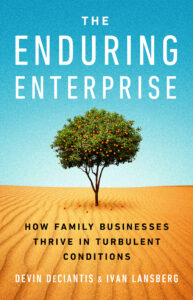Confronting an Existential Crisis:
What is the Value of Family in Family Philanthropy?
Family philanthropy offers families the opportunity to work together in service of a greater good—and in so doing, strengthen family relationships, transform individual participants, and address pressing social problems. But in today’s evolving landscape, family foundations—particularly more established ones—face a critical internal reckoning. More and more in our work with philanthropic families, we see family members questioning their roles and wondering if their contributions are truly meaningful. This introspection, fueled by a growing emphasis on equity and impact, raises a fundamental question: What is the value of our family in our family philanthropy now?
This existential inquiry demands honest and thorough examination. While each family’s conclusions may differ, responsible stewardship requires that families grapple with these complex issues in a thoughtful and well-structured way.
A Shifting Landscape: The Context for Change
In his book Generations of Giving, Kelin Gersick, co-founder of LGA, writes about the unique social contract of private philanthropy in the U.S. He contends that people of means put resources into private foundations, where those dollars are effectively matched by the tax-paying public in the form of tax exemptions. The descendants of those original donors can then continue—in perpetuity—to determine the use of those resources for the “public’s benefit.” They operate with incredible latitude and little accountability: no electorate, no shareholders, little oversight.
This construct is facing increasing scrutiny as critics have questioned the justification of tax-subsidized family philanthropy and the concentration of power in the hands of a privileged few, arguing that this can perpetuate inequality and contradict democratic principles.
These critiques resonate deeply within many philanthropic families. The wealth that supports the foundation is often intertwined with family members’ personal wealth, making these sector-wide challenges intensely personal. The ambivalence and uncertainty about their contributions to the foundation echo larger questions of worth, legacy and privilege.
More and more, we are hearing from participants in family philanthropy that are questioning their personal contributions to their family philanthropy and their family’s sustained control over philanthropic resources. And while these questions are emerging from all segments of family philanthropy, they are particularly pronounced in more mature and established family foundations. Specifically, those in the third generation of leadership and beyond, far removed from the wealth creation that produced the foundation, with strategic giving programs and expert professional staff, and non-family board members who bring lived and professional experience relevant to the foundation’s work. Family members are wondering if it’s worth it—for them, for the family, for the world—to continue to invest in involving the family in the family philanthropy. In many ways these institutions are grappling with an existential crisis.
The Value Proposition of Family Philanthropy
In our discussions with families wrestling with these questions, we’ve found that it can be helpful to frame the inquiry in terms of the potential costs and benefits of ongoing family involvement:
- What are the advantages of family involvement for the foundation, the community, and the family itself? Does family involvement add demonstrable value, and if so, how?
- What are the costs of family authority and engagement for the foundation, for society, and for the family? What is required to continue to engage the family in the work?
Ultimately, the key question is whether the benefits outweigh the costs: Is our family’s continued stewardship of philanthropic resources justified? Examining these costs and benefits requires a willingness to engage in honest self-reflection and challenging conversations, which don’t always come naturally to enterprising families.
The Benefits of Family Involvement
The benefit to the family of involvement in family philanthropy is often clear: it can bring relatives closer together, provide satisfying experiences for individual members and for the family as a whole, and enable access and opportunities that can enhance members’ lives in social and professional domains.
There can also be benefits to the foundation from ongoing family involvement. As is the case in other arenas of family enterprise, families often bring a long-term orientation, risk tolerance, and commitment to ethical practice; their name is on the door and they want to ensure that the foundation operates in a manner that makes the family proud. By virtue of their reputation, access and networks, family participants can advance the foundation’s mission by raising awareness of the issues it supports.
We also posit that there can be a benefit to the public that comes from the transformation of individuals and families engaged in philanthropy. There are countless examples of individuals who, exposed to philanthropy via participation in their family foundation, become passionate and prolific givers. Their engagement inspires them to think differently about how they utilize their wealth, increasing the flow of resources for public benefit while also providing greater personal fulfillment.
The Costs of Family Involvement
It is also true that the ongoing involvement of family members in philanthropy comes at a cost. Some of that is born by society at large: see critiques by Rob Reich, Edgar Villanueva, and Anand Giridharadas, to name a few. By taking resources out of the public domain (in the form of tax revenues) and allowing a privileged few to determine the allocation of those dollars, the system of private philanthropy can perpetuate inequality.
There are also costs to the institution to maintain family engagement over generations. Many family foundation CEOs would tell you that engaging the family and managing complex family dynamics is the hardest part of their job. Family foundations often invest significant resources—staff and board time, travel expenses—to involve the family.
Finally, there may be costs to the family that come from ongoing participation in the family foundation. For some, participation is seen as an obligation or burden; for others, philanthropy is a source of conflict, one more arena where they must work with family members with whom they do not agree.
Earning the Right to Lead: How Families Must Show Up
Families may reasonably come to different conclusions on the question of whether the benefits of their ongoing engagement justifies the costs. For most families—like so much in family philanthropy—the answer is not black-or-white, but “it depends.” It depends how they show up in the work, how seriously they take their responsibilities to the public on whose behalf they are stewarding these resources.
This requires consistent, prepared, and engaged participation in foundation activities. Members should be willing to develop skills and knowledge relevant to serving as directors, and selection for these roles should be based on merit, not entitlement nor obligation.
Key factors that support constructive and value-added contributions include:
- Defining a shared family value system to inform and enhance strategic decision-making.
- Addressing internal family dynamics outside of foundation activities to ensure effective governance.
- Valuing and empowering the expertise of staff and independent directors.
- Being aware of blind spots and bringing the perspectives from members of the communities the foundation serves into the work.
- A willingness to contribute the family’s non-financial assets to further the mission by utilizing family networks and reputation to elevate issues.
Shifting the orientation so that the focus is on how the family serves the foundation—not the other way around—and defining what is needed to serve it well can help families determine if they have the commitment and capacity for continuity.
Conclusion: A Necessary Conversation
With the privilege of stewarding a public trust comes the responsibility to be honest about the social contract of private philanthropy and brave enough to ask difficult questions. Family involvement in foundations can be extraordinarily powerful. However, the cost of this authority must be reasonable and proportionate to the value contributed. It cannot be based solely on past contributions; it must be earned by each generation to maintain the trust and credibility essential for success. In our experience, the families that do this work best—where there is ongoing energy and a shared sense of purpose—are the ones who have wrestled with those hard questions and used them as an opportunity to rechart a course toward a future with greater clarity and commitment.
For some families, that future is one of revitalization: a moment to reflect on the family legacy and foundation’s efforts, and a chance to involve new generations in carrying it forth. For some it results in redefinition, finding new areas of giving and ways of operating that better energize and engage the family, and better serve the community. Others may rethink family involvement altogether, choosing to spend down the foundation or transition authority for its ongoing operation to people outside of the family.
Every family will arrive at its own answer. To be effective and justify their participation, families must ask the hard questions and engage in honest self-reflection. We have witnessed family philanthropy at its best, where family participation is a net positive for everyone involved. This occurs when the focus is on doing meaningful work, learning together, and contributing to something larger than themselves.








